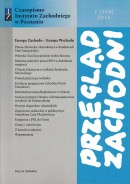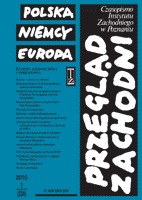



The border between what is human – man’s inalienable and inherent rights and needs – and what is public – institutionalization of human life in the state, reaches down to the very basis of the axiological and normative system underlying the legal order of the institution of the state. This border consists in the almost ‘‘barring’’ character of normative acts of state institutions which often lack public transparency, and in extreme cases are even contradictory to the endeavors of democratic countries (e.g. clarity, accessibility and openness of the principles and rules, norms and values that underlie the governing of the state). The value of democracy lies in its normative acts, so-called metaregulations or universal principles from which all other acts of state law and order originate. The bond between morality and state institution – disrupted and underestimated in history – actually does exist. The question is: Is the dependence and bond between morality and the state reflected and present in the process of creating democratic, legal acts of the state and institutions of state administration?
More...
The issue of the border and cooperation within the borderland was an important element of relations between Poland and the GDR from 1949 to 1971. The Odra and the Nysa Łużycka were the cause of unofficial controversies on the Warsaw – East Berlin line, camouflaged by an officially declared friendship and common ideology. The character of the Western border was determined by the Polish-East German relations in the borderland, which were mostly based on ideological-political grounds. Cooperation in the borderland consisted mainly in formal propaganda contacts between parties and state institutions. In consequence in the period under discussion it was impossible to develop processes integrating the societies on both banks of the Odra and Nysa Łużycka, whereas economic relations could only be maintained on a limited scale.
More...
The author draws attention to certain subsidiary processes connected with the ‘‘opening’’ of borders, mainly as part of a larger process of European integration. The opening of borders met with criticism as in several cases it paradoxically led to exclusion. Firstly, a regularity was noticed that the smaller the border restrictions inside a given area (here: the European Union), the stricter the border regime on its outskirts. At a certain point, division into the centre and peripheries contributed to an evaluative approach to countries and societies by creating an elite club for members (of the European Union) and all the other states that aspired to membership. Another aspect concerns migration movements, but also small-scale cross-border traffic or the traffic of national minorities. For the above mentioned categories of people, tightening up borders has led to problems with entering the territory of the European Union. Especially immigrants from outside Europe must take into account serious obstacles in the form of a system of physical barriers and blockades. The third aspect concerns a civilization criterion which is becoming clearly visible in the course of demarcation of the new borders of Europe. Despite a declared promotion of multiculturalism, the limes of Europe have more or less consciously been drawn along the borderline of Christian Europe. Controversy surrounding Turkey’s candidacy can be seen as a litmus test in the debate on European identity built on the basis of civilizational affiliation. According to the author, new aspects of exclusion by borders and borderlands (which turned out not to be open as wide as initially declared) were insufficiently represented in the discussion on the effects of European integration.
More...

The article is an attempt to trace the changing role of international borders in the international flow of capital in the form of direct foreign investments (DFI). Borders understood in the conventional sense as factors hindering a free migration of investments (disruption of optimal allocation) but at the same time also vindicating the existence of many capital flows (the motive of availing oneself of broadly understood differences) seem to be losing significance. However, what is being observed is the growing role of informal, ‘‘soft’’ and tacit borders that render the making of full profit impossible. They can be particularly painful in the case of knowledge-seeking investments made in clusters. Narrow specialization accompanied by a hermetic character of many such clusters is a major barrier in the activity of foreign business entities. Contrary to state borders, this barrier cannot be lifted by means of imposed administrative decisions.
More...

The article discusses the cultural situation within a broadly understood borderland of Western and Eastern Europe spanning the interfluve of the Vistula and the Dnieper. The period selected for the study, i.e. the 3rd millennium B.C. was characterized, in the light of current knowledge, by varied forms of cultural contacts that brought together the societies of the Western and Eastern European cultural realm. The socio-cultural transformations that took place in those times resulted at the end of the 3rd millennium B.C. in a new landscape of this cultural borderland.
More...
Political borders in Europe used to be treated as linear systems from the 17th century onward but this approach became widespread only in the 19th century. Controversy surrounding the linear character of borders, not just political but regional ones as well (concerning e.g. socio-economic links or cultural phenomena) was also present in the domain of geography, giving rise to the problem of delimitation of borders on the land (e.g. political borders) and on the map. The paper analyzes some geographical accounts of the problem of borders and describes some mechanisms that affect the stability or changeability of political borders in Europe. Finally, attention is drawn to the issue of particular countries’ access to sea coasts and to the subject of their territorial integrity.
More...
The article looks at the economic situation of the population in both parts of a divided Cyprus and its political problems, especially those which arose after the Turkish invasion of 1974. Relations established between the two parts of the island after 2003 are also discussed. The last section of the article brings an analysis of the current situation, expounding the opportunities and obstacles on the way to an economic reunification of Cyprus into one country.
More...

The legal-international subjectivity of united Europe had for many years remained a legally unresolved problem. When the European Union was created by force of the Treaty of Maastricht, only its first pillar, the European Community, possessed legal personality. The other two pillars that make up the Union implemented their policies through international cooperation. A lack of the subjectivity of those two pillars resulted in the fact that the European Union did not enjoy an adequate legal mandate on the international arena. Its legal subjectivity was only regulated by the Treaty of Lisbon, which granted the European Union its legal personality.
More...

The aim of the article is to identify the current trends in the process of convergence of the member states of the EU within the sphere of innovativeness and to trace the directions of European policy supporting innovative development towards securing stable economic growth. The above formulated aim is achieved by presenting arguments for the significance of technical progress and innovation to economic growth from the perspective of the major trends in economic thought. On the basis of such data as the level of innovativeness of European economy, and the size and structure of expenditures on research and development it is possible to verify the thesis that the ensuring of a stable economic growth and obtaining competition advantage by the member states of the EU depends on an increase in expenditure on research and development as well as on the development of systems of education.
More...
The article characterizes the situation of Churches and religious associations in the Czech Republic and Slovakia after 1989. Along with the onset of transformations of the political system, previously marginalized and persecuted religious associations obtained the possibility of a free development and independence from state authorities, while their members were guaranteed religious liberties. Following the division of the Czechoslovak state into two independent republics – Czech and Slovak – Churches and religious associations have enjoyed freedom, conditions have also been created for development of their activity, religious as well as charitable, cultural, educational, etc. Appropriate legal regulations have also been introduced. However, many problems still remain unsolved, above all the problem of financing the Churches, and in the case of the Czech Republic also the restitution of Church property and the concordate. The situation of religious associations in those countries is also influenced by a change of attitudes toward religion. The highly secularized Czech society shows a well-advanced indifference to religious matters, whereas in Slovakia the Church enjoys social trust and believers make up a large section of the society.
More...
The last forty years were a period when mechanisms of transborder cooperation in the Upper Rhine region were formed. The troubled past of the French-Swiss-German border territory no longer blocks the way of partners across the Rhine to seek practical solutions to problems in the life of the inhabitants of those areas. From the perspective of Paris or Berlin, the Upper Rhine region is not infrequently seen to be peripheral and unimportant, but in fact it lies in the centre of Europe and is one of the richest areas in the European Union. Opportunities that follow from such a location motivate local communities to tighten mutual ties and develop various forms of cooperation (e.g. the RegioTriRhena Council, the Upper Rhine Conference, Trilateral Congresses, the Upper Rhine Eurodistricts). Many of those are pioneering initiatives that serve as models for other European border regions.
More...
Distinctiness and diversity of perspectives, lack of a unified, precise strategy of action and conflicts between the governments of particular countries are factors responsible for the fact that the condition of Europe on the international arena is seen as unstable. This is directly reflected in the level of security and will affect the position of the Old Continent in the future. Those countries which have taken upon themselves the task of creating a new European order often vary in their particular beliefs and preferences. On the one hand there is an assumption of codependence and integration of European countries, which is treated as a guarantee of their development and security, whereas on the other hand more and more often a process of regionalization can be noticed. The contradictoriness of unification results from a lack of one universal conception of a „United Continent”. The author of the article seeks to answer the question which vision – unification or regionalization – is better for the development of contemporary Europe. However, does political strategy today make it at all possible to give a univocal answer?
More...
Maria Wojtczak: Doktorat honoris causa dla profesora Huberta Orłowskiego Maria Wagińska-Marzec: „Historia i Życie”. O konkursie wiedzy historycznej dla młodzieży szkół licealnych w Polsce Maria Wojtczak: Honorary Doctorate for Professor Hubert Orłowski Maria Wagińska-Marzec: “History and Life”. On historical Knowledge Competition for high School Students in Poland
More...
The article seeks to answer the question of the role and significance of religion in constructing contemporary Slovak national identity. In his attempted answer, the author describes the relations between religion and the nation, and religion and nationalism in Central-Eastern Europe. He then reflects on the issue of the place of Christianity within the public sphere as an object of political debate in Slovakia after 1989. The answer to the problem is sought by analyzing both the public discourse in Slovakia after 1989 and by referring to the symbolic sphere (the symbolism of currency, national feasts and public places).
More...